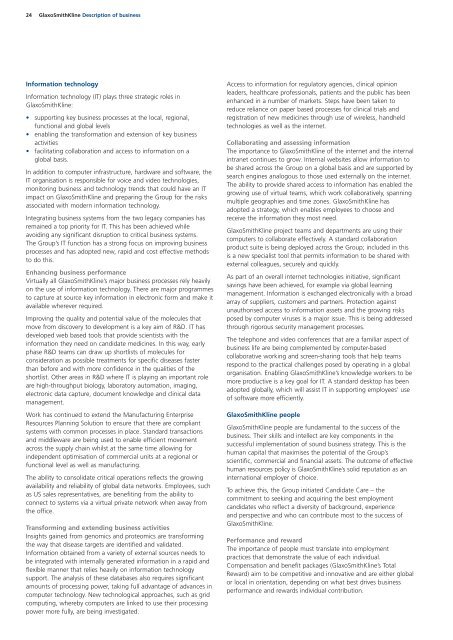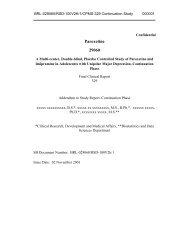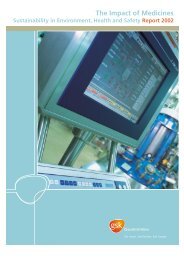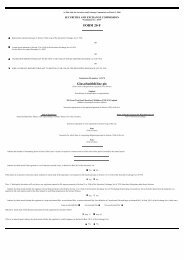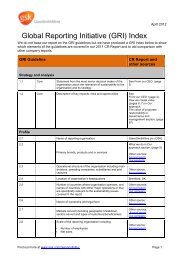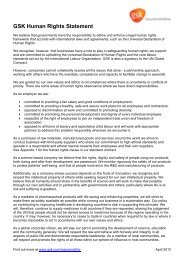GSK Annual Report 2002
GSK Annual Report 2002
GSK Annual Report 2002
Create successful ePaper yourself
Turn your PDF publications into a flip-book with our unique Google optimized e-Paper software.
24 GlaxoSmithKline Description of business<br />
Information technology<br />
Information technology (IT) plays three strategic roles in<br />
GlaxoSmithKline:<br />
• supporting key business processes at the local, regional,<br />
functional and global levels<br />
• enabling the transformation and extension of key business<br />
activities<br />
• facilitating collaboration and access to information on a<br />
global basis.<br />
In addition to computer infrastructure, hardware and software, the<br />
IT organisation is responsible for voice and video technologies,<br />
monitoring business and technology trends that could have an IT<br />
impact on GlaxoSmithKline and preparing the Group for the risks<br />
associated with modern information technology.<br />
Integrating business systems from the two legacy companies has<br />
remained a top priority for IT. This has been achieved while<br />
avoiding any significant disruption to critical business systems.<br />
The Group’s IT function has a strong focus on improving business<br />
processes and has adopted new, rapid and cost effective methods<br />
to do this.<br />
Enhancing business performance<br />
Virtually all GlaxoSmithKline’s major business processes rely heavily<br />
on the use of information technology. There are major programmes<br />
to capture at source key information in electronic form and make it<br />
available wherever required.<br />
Improving the quality and potential value of the molecules that<br />
move from discovery to development is a key aim of R&D. IT has<br />
developed web based tools that provide scientists with the<br />
information they need on candidate medicines. In this way, early<br />
phase R&D teams can draw up shortlists of molecules for<br />
consideration as possible treatments for specific diseases faster<br />
than before and with more confidence in the qualities of the<br />
shortlist. Other areas in R&D where IT is playing an important role<br />
are high-throughput biology, laboratory automation, imaging,<br />
electronic data capture, document knowledge and clinical data<br />
management.<br />
Work has continued to extend the Manufacturing Enterprise<br />
Resources Planning Solution to ensure that there are compliant<br />
systems with common processes in place. Standard transactions<br />
and middleware are being used to enable efficient movement<br />
across the supply chain whilst at the same time allowing for<br />
independent optimisation of commercial units at a regional or<br />
functional level as well as manufacturing.<br />
The ability to consolidate critical operations reflects the growing<br />
availability and reliability of global data networks. Employees, such<br />
as US sales representatives, are benefiting from the ability to<br />
connect to systems via a virtual private network when away from<br />
the office.<br />
Transforming and extending business activities<br />
Insights gained from genomics and proteomics are transforming<br />
the way that disease targets are identified and validated.<br />
Information obtained from a variety of external sources needs to<br />
be integrated with internally generated information in a rapid and<br />
flexible manner that relies heavily on information technology<br />
support. The analysis of these databases also requires significant<br />
amounts of processing power, taking full advantage of advances in<br />
computer technology. New technological approaches, such as grid<br />
computing, whereby computers are linked to use their processing<br />
power more fully, are being investigated.<br />
Access to information for regulatory agencies, clinical opinion<br />
leaders, healthcare professionals, patients and the public has been<br />
enhanced in a number of markets. Steps have been taken to<br />
reduce reliance on paper based processes for clinical trials and<br />
registration of new medicines through use of wireless, handheld<br />
technologies as well as the internet.<br />
Collaborating and assessing information<br />
The importance to GlaxoSmithKline of the internet and the internal<br />
intranet continues to grow. Internal websites allow information to<br />
be shared across the Group on a global basis and are supported by<br />
search engines analogous to those used externally on the internet.<br />
The ability to provide shared access to information has enabled the<br />
growing use of virtual teams, which work collaboratively, spanning<br />
multiple geographies and time zones. GlaxoSmithKline has<br />
adopted a strategy, which enables employees to choose and<br />
receive the information they most need.<br />
GlaxoSmithKline project teams and departments are using their<br />
computers to collaborate effectively. A standard collaboration<br />
product suite is being deployed across the Group; included in this<br />
is a new specialist tool that permits information to be shared with<br />
external colleagues, securely and quickly.<br />
As part of an overall internet technologies initiative, significant<br />
savings have been achieved, for example via global learning<br />
management. Information is exchanged electronically with a broad<br />
array of suppliers, customers and partners. Protection against<br />
unauthorised access to information assets and the growing risks<br />
posed by computer viruses is a major issue. This is being addressed<br />
through rigorous security management processes.<br />
The telephone and video conferences that are a familiar aspect of<br />
business life are being complemented by computer-based<br />
collaborative working and screen-sharing tools that help teams<br />
respond to the practical challenges posed by operating in a global<br />
organisation. Enabling GlaxoSmithKline’s knowledge workers to be<br />
more productive is a key goal for IT. A standard desktop has been<br />
adopted globally, which will assist IT in supporting employees’ use<br />
of software more efficiently.<br />
GlaxoSmithKline people<br />
GlaxoSmithKline people are fundamental to the success of the<br />
business. Their skills and intellect are key components in the<br />
successful implementation of sound business strategy. This is the<br />
human capital that maximises the potential of the Group’s<br />
scientific, commercial and financial assets. The outcome of effective<br />
human resources policy is GlaxoSmithKline’s solid reputation as an<br />
international employer of choice.<br />
To achieve this, the Group initiated Candidate Care – the<br />
commitment to seeking and acquiring the best employment<br />
candidates who reflect a diversity of background, experience<br />
and perspective and who can contribute most to the success of<br />
GlaxoSmithKline.<br />
Performance and reward<br />
The importance of people must translate into employment<br />
practices that demonstrate the value of each individual.<br />
Compensation and benefit packages (GlaxoSmithKline’s Total<br />
Reward) aim to be competitive and innovative and are either global<br />
or local in orientation, depending on what best drives business<br />
performance and rewards individual contribution.


